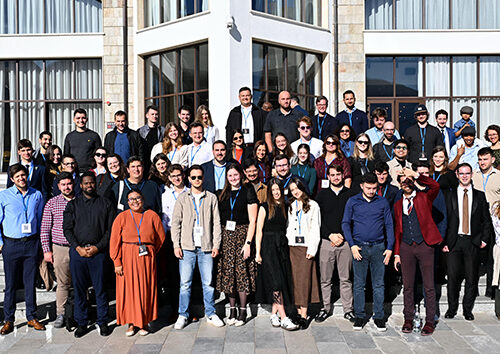25 January 2021 | Brussels, Belgium [ADRA Europe]
At ADRA (Adventist Relief Agency), we refuse to accept the prediction that 24 million more children and young people are at risk of dropping-out of school due to disruptions caused by the Covid-19 pandemic. Even before the pandemic, there were 258 million school age learners without access to education.
ADRA teams across the globe, together with partners, dedicate efforts to ensure that all children, everywhere receive a quality education. But our efforts alone are simply not enough. ‘Every child, everywhere in school’ is an urgent call to every individual and global community. We call upon governments, decision makers, people of power, organisations with resources, fellow non-governmental organisations, communities of faith and all others, to address the consequences of the pandemic together as one global community and in a manner that will enable all learners to continue with education in 2021 and beyond.
Risk of “destroying” success achieved during the last three decades
In the last three decades the world has experienced an extraordinary period of progress:
- Child mortality has plummeted from 12.5 million to 5.3 million children per year.
- Life expectancy has increased from 64 years to 73 years.
- Gross Domestic Product (GDP) per capita has increased by 50%.
- Extreme poverty has fallen from 36% of the world’s population to just 10%.
Such results have been coupled with (and propelled by) a global education revolution. As the societal and individual benefits of education have been increasingly recognised, government financing and household demand for education have expanded, rapidly:
- The number of out-of-school children has fallen dramatically from 372 million in 1990 to 258 million in 2018.
- Illiteracy has fallen over the same period, from one out of every four people, globally, to less than one in seven.
- The number of girls out of school has fallen by half, eliminating the disparity between girls and boys on this front.
However, more recently, progress on ensuring all children receive a quality education has stalled. Since 2015, the number of out-of-school children has hovered at around 258 million. 258 million of people is the total population living in the four largest EU countries together (Germany, France, Italy, and Spain). Deeper analysis reveal that the number of out-of-school primary children has been stagnant for more than a decade. Then came the pandemic …
The most vulnerable are always hit the hardest
The pandemic is responsible for the largest disruption to education in history, affecting nearly 1.6 billion learners in more than 190 countries, across every continent. If not dealt with urgently, the impact will be generational and stands to reverse decades of progress. The most vulnerable will be the hardest hit. Almost 24 million additional students are at risk of dropping out of education or of not having access to education during the year 2021, due to the economic impact of the COVID-19 pandemic, alone. 24 million people is the total number of people living in the nine smallest EU countries (Malta, Cyprus, Estonia, Latvia, Slovenia, Lithuania, Croatia, Ireland, and Slovakia).
Challenges versus possible solutions
To reverse the negative trends and post-pandemic consequences in access to education, ADRA suggests focusing on four main areas with the following proposed solutions:
- Financing for education
- Inclusion in education
- Education quality and retention
- Education during the crisis
Financing for education:
Challenge: The impact of the pandemic on the global economy is the tightening of government budgets. Education aid is set to drop by USD2 billion representing a 12% reduction on its record high in 2018. And pre-pandemic levels of aid are not set to recover until 2024. This will compound the heightened pressure on low and middle-income countries that are facing the dual challenges of skyrocketing needs and decreased economic resources.
Possible solutions:
- Increased domestic resource mobilisation for education (ensure spending meets minimum financing benchmarks: 4% – 6% of GDP and 15% – 20% of government expenditure).
- Increased aid for education (lift aid to 0.7% of Gross National Income and dedicate at least 10% to education).
- Reduce remittance costs to increase household expenditure on education.
- Curtail tax dodging by large multinationals and high net wealth individuals to increase available domestic resources for education.
Inclusion in education:
Challenge: The children most likely to be excluded from education come from families experiencing disadvantage due to poverty, language, location, gender, and ethnicity.
Possible solutions:
- Challenge social norms and behaviours:
- Local and global advocacy addressing participation in education as well as tackling negative attitudes, stigma, and violence.
- Promoting gender-responsive education planning.
- Set and enact equitable laws and policies:
- Committing to international frameworks that promote disability-inclusive development.
- Improving data on children living with a disability.
- Developing inclusive education policies (including improved teacher training on special education, curricula that address issues of inclusion and building more accessible school facilities).
Education quality and retention:
Challenge: An estimated 274 million children attending school are not learning the basic skills necessary to lead productive and healthy lives. Half of primary school children are not learning basic foundational skills, like literacy and numeracy, and three-quarters of secondary school students are not learning basic secondary-level skills. The problem is compounded, when education quality is low, dropout rates rise.
Possible solutions:
- Improve learning outcomes through:
- Instruction: implement participatory teaching and learning techniques.
- Training: Increasing the quality and quantity of teachers.
- Assessment: Implement better tools to measure learning outcomes.
- Curricula: Engage teachers in effective policy dialogue.
- Implement better tools to measure learning outcomes:
- Improving learning outcomes.
- Improving school infrastructure.
- Improving inclusion.
Education during crisis:
Challenge: Before the pandemic, 104 million children aged 5-17 were deprived of education due to conflicts and natural disaster crises. The Pandemic has seen this number rise exponentially, 1.6 billion learners have been impacted including 99% of all students in lower- and middle-income countries. But as COVID-19 began to spread, this number has risen, exponentially.
Possible solutions:
Respond to crisis
- Countries prone to disaster and affected by conflict should factor crisis into their long-term education planning.
- Refugee children are included in national education systems.
- Education is not the first casualty of the crisis. Donor countries should provide flexible and accelerated funding in times of crisis, designated for education.
- As governments formulate their plans to reopen schools, safety for all and inclusion should be incontrovertible considerations
To read the full report and arguments behind every proposed action toward a solution, please read the full ADRA Global education report here.
tedNEWS Staff: Victor Hulbert, editor; Deana Stojković, associate editor
119 St Peter’s Street, St Albans, Herts, AL1 3EY, England
E-mail: [email protected]
Website: www.ted.adventist.org
tedNEWS is an information bulletin issued by the communication department of the Seventh-day Adventist Church in the Trans-European Division. Readers are free to republish or share this article with appropriate credit including an active hyperlink to the original article.



